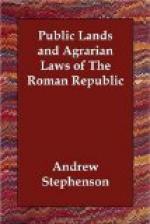[Footnote 1: Rudorff, Ackergesetz des Spurius Thorius, Zeitschrift fuer geschichtliche Rechtswissenschaft, Band X, s. 1-158. Corpus Inscriptionum Latinarum, vol. V, pp. 75-86. Wordsworth, Specimens and Fragments of Early Latin, 440-459.]
[Footnote 2: Appian, Bell. Civ., I, c. 27.]
[Footnote 3: Ihne, Roman History, V, 9.]
[Footnote 4: Momm., Rom. Hist., III, 165.]
[Footnote 5: Long, Decline of the Rom. Rep., I, 352. See Lange, Roem. Alter., III, 48.]
[Footnote 6: Long, loc. cit.]
[Footnote 7: Momm., III, 161; Ihne, V, 10.]
[Footnote 8: Long, loc. cit.]
[Footnote 9: Lange, III, 48-49; Marquardt u. Momm., IV, 108.]
[Footnote 10: Long, loc. cit. Momm., III, 167-168; Ihne, V, 8-10.]
[Footnote 11: Appian, I, c. 27.]
[Footnote 12: Long, I, 353.]
[Footnote 13: Long, I, 354.]
[Footnote 14: Ihne, V, 10-11.]
[Footnote 15: Long, I, 353; Wordsworth, 440; Momm., III, 165, note; Ihne, V, 9; Lange, III, 48; Appian, I, c. 27.]
[Footnote 16: Cicero, Brut., 36.]
[Footnote 17: Cicero, De Orat., II, 70.]
[Footnote 18: Marquardt u. Momm., Roem. Alter., IV, 108, n. 4; Wordsworth, 441.]
[Footnote 19: Corpus Inscriptionum Latinarum, vol. I, p. 74.]
[Footnote 20: Appian, I, c. 27.]
[Footnote 21: Long, I, 355; Wordsworth, 440.]
[Footnote 22: Long, I, 355; Wordsworth, 440; See Rudorff, Ack. des Sp. Thor.]
[Footnote 23: Zeitschrift fuer geschichtliche Rechtswissenschaft, Band X, s. 1-194.]
[Footnote 24: C.I.L., I, pp. 75-86.]
[Footnote 25: Long, I, 356.]




